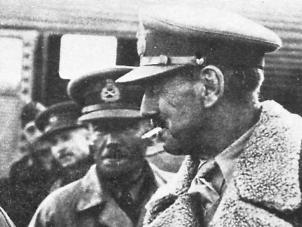|
|
Sir.RICHARD
NUGENT O'CONNOR
(1889-1981) |
|

|
|
Sir.RICHARD
NUGENT O'CONNOR
(1889-1981) |
|
Service
in World War I
O'Connor's
early service during World War I included periods as Signal Officer of 22
Brigade in 7 Division; Captain, in command of 7th Division Signal Company; and
Brigade Major in 91 Brigade, 7th Division. In February 1915 he was awarded the
Military Cross, and in March of that year saw service in the Battle of Arras,
and attacks on Bullecourt.
Prisoner
of War, Castle Vincigliata Fiesole, Florence ( Italy) campo 112
O'Connor
and Neame were captured by a German reconnaissance night patrol on 7 April 1941,
and O'Connor spent the next two and a half years as a Prisoner of War, mainly
near Florence in Italy. O'Connor found himself in impressive company, fellow
inmates including Maj Gen Sir Adrian Carton de Wiart and Air Vice Marshal O T
Boyd. Escape plans were quickly laid, and the escape narratives (4/5/1 and
4/5/2) closely document, with the aid of plans, the first attempt, over the
castle walls and subsequent month's solitary confinement. The second initially
successful attempt, via the escape tunnel constructed between October 1942 and
March 1943, was made in the company of de Wiart.
The two were captured in the
region of the Po Valley, Bologna while Brig Combe and AVM Boyd reached Como.
Fellow inmates Brigs Miles and James Hargest secured their escape by journeying
to Switzerland. The final and successful escape was made after the Italian
surrender (8 settembre). Following unsuccessful attempts at a rendezvous with a submarine at Cattolica
and Cervia, O'Connor arrived by boat at Termoli and transferred to
Bari as the guest of General Alexander on 21 December 1943.O'Connor
maintained links in later life made with members of the Italian resistance, who
had sheltered him during his escape.
 O
Connor era figlio di un ufficiale di carriera di stanza in India e nel 1914 era
già al fronte a fianco dei Francesi. Nel 1917, all'atto del trasferimento del
Corpo d'armata inglese sul Piave, comanda un battaglione. Per una brillante azione alla
Grave di Papadopoli negli ultimi giorni di guerra ottiene la medaglia d'argento
al valor militare. Nel 1936 comandava una brigata in India e
due anni dopo era Governatore militare a Gerusalemme. Da qui il Gen. Maitlnad
"Jumbo" Wilson,
comandante le truppe inglesi in Egitto, lo fece chiamare il 7 giugno 1940 per
assegnarli il comando della Western Desert Force. Gli inglesi all'epoca,
sopravvalutandoci, pensavano di dover fare una guerra di difesa in attesa di
tempi migliori, circondati come erano da territori e mari italiani. Anche se
leggermente balbuziente, riusciva ad essere molto chiaro e convincente coi suoi
sottoposti sulla tattica da seguire. Bloccato nella sua offensiva dal prelievo
di uomini per la Grecia, finì prigioniero il 7 aprile del 1941 per un errore
del suo autista. Durante la campagna d'Africa portò sempre il nastrino della
medaglia d'argento conferitagli dagli Italiani nella Grande Guerra. "Il
più affascinante degli scontri nel deserto contro Rommel non ebbe mai
luogo" così ebbe a dire Correlli Barnett storico inglese.
Fuggito nei giorni dell'armistizio, venne imbarcato su un sottomarino che lo
portò a Bari presso il comando di Alexander. Ottiene quindi un comando in Normandia all'VIII C.d.A, ma un
insucesso a Caen lo fa relegare dal comando attivo. Trasferito in India, Vi
resta fino al 1946 quando, richiamato da Montgomery, si occupa della
smobilitazione, compito questo che lo mette in conflitto con molti reduci, che
credevano di aver trovato un posto di lavoro. Nel 1948 si ritira a vita privata
fino alla morte avvenuta il 17 giugno 1981.
Coi partigiani
che parteciparono alla sua liberazione mantenne negli anni rapporti epistolari.
O
Connor era figlio di un ufficiale di carriera di stanza in India e nel 1914 era
già al fronte a fianco dei Francesi. Nel 1917, all'atto del trasferimento del
Corpo d'armata inglese sul Piave, comanda un battaglione. Per una brillante azione alla
Grave di Papadopoli negli ultimi giorni di guerra ottiene la medaglia d'argento
al valor militare. Nel 1936 comandava una brigata in India e
due anni dopo era Governatore militare a Gerusalemme. Da qui il Gen. Maitlnad
"Jumbo" Wilson,
comandante le truppe inglesi in Egitto, lo fece chiamare il 7 giugno 1940 per
assegnarli il comando della Western Desert Force. Gli inglesi all'epoca,
sopravvalutandoci, pensavano di dover fare una guerra di difesa in attesa di
tempi migliori, circondati come erano da territori e mari italiani. Anche se
leggermente balbuziente, riusciva ad essere molto chiaro e convincente coi suoi
sottoposti sulla tattica da seguire. Bloccato nella sua offensiva dal prelievo
di uomini per la Grecia, finì prigioniero il 7 aprile del 1941 per un errore
del suo autista. Durante la campagna d'Africa portò sempre il nastrino della
medaglia d'argento conferitagli dagli Italiani nella Grande Guerra. "Il
più affascinante degli scontri nel deserto contro Rommel non ebbe mai
luogo" così ebbe a dire Correlli Barnett storico inglese.
Fuggito nei giorni dell'armistizio, venne imbarcato su un sottomarino che lo
portò a Bari presso il comando di Alexander. Ottiene quindi un comando in Normandia all'VIII C.d.A, ma un
insucesso a Caen lo fa relegare dal comando attivo. Trasferito in India, Vi
resta fino al 1946 quando, richiamato da Montgomery, si occupa della
smobilitazione, compito questo che lo mette in conflitto con molti reduci, che
credevano di aver trovato un posto di lavoro. Nel 1948 si ritira a vita privata
fino alla morte avvenuta il 17 giugno 1981.
Coi partigiani
che parteciparono alla sua liberazione mantenne negli anni rapporti epistolari.
| 1.
Order of the Bath (Knight
Commander of the Bath-KCB) 2. Order of the British Empire (In several grades, including Officer and Commander- OBE, CBE) 3. Distinguished Service Order (DSO) 4. Military Cross (MC) 5. Distinguished Flying Cross (DFC) 6. Air Force Cross (AFC) 7. Distinguished Conduct Medal (DCM) 8. RAF Conspicuous Gallantry Medal 9. George Medal (GM) 10.Military Medal (MM) 11.Distinguished Flying Medal (DFM) 12.Air Force Medal (AFM) 13.British Empire Medal (BEM) - (Ribbon is smaller than that of the Order) 14.1939-45 Star 15.Atlantic Star 16.Air Crew Europe Star 17.Africa Star 18.Pacific Star 19.Burma Star 20.Italy Star 21.France and Germany Star 22.Defence Medal 23.1939-45 War Medal |
|